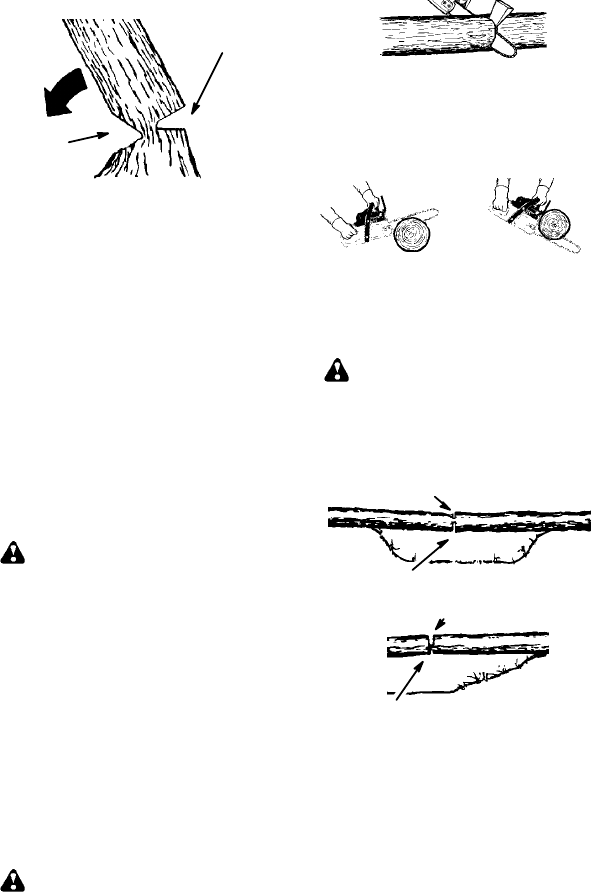
12
Opening
of felling
cut
Closing of
notch
Hinge holds tree on stump and helps
control fall
NOTE: Before felling cut i s complete, use
wedges to open the cut if necessary to
controlthedirectionof fall. To avoidkickback
and chain damage, use wood or plastic
wedges, but never steel or iron wedges.
S Be alert to signs that the tree is ready to
fall: cracking sounds, widening of the fell-
ing cut, or movement in the upper
branches.
S As tree starts to fall, stop saw , put itdown,
and get away quickly on your planned re-
treat path.
S DO NOT cut down a partially fallen tree
with your saw. Be extremely cautious with
partially fallen trees that may be poorly
supported. When a tree doesn’t fall com-
pletely,setthesaw asideandpulldownthe
tree with a cable winch, block and tackle,
or tractor .
CUTTING A FALLEN TREE
(BUCKING)
Bucking is the term used for cutting a fallen
tree to the desired log size.
WARNING: Do not stand on the log
being cut. Any portion can roll causing loss
of footing and control. Do not stand downhill
of the log being cut.
IMPORTANT POINTS
S Cut only one log at a time.
S Cut shattered wood very carefully; sharp
pieces of wood could be flung toward opera-
tor .
S Use a sawhorse to cut small logs. Never
allow another person to hold the log while
cutting andnever holdthe logwith your leg
or foot.
S Do not cut in an area where logs, limbs,
and roots are tangled such as in a blown
down area. Drag the logs intoa clear area
before cutting by pulling out exposed and
cleared logs first.
TYPES OF CUTTING U SED FOR
BUCKING
WARNING: Ifsaw becomespinched
or hung in a log, don’t try to force it out. You
can lose control o f t he s aw resulting in injury
and/or damage to the saw. S top the saw,
drive a wedge of plastic o r wood into the cut
until thesaw can beremoved easily. Restart
the saw and carefully reenter t he cut. To
avoid kickback and chain damage, do not
use ametal w edge. Do notattempt torestart
your saw when it is pinched or hung in a log.
Use a wedge to remove pinched saw
Turn saw OFF and use a plastic or
wooden wedge to force cut open.
Overcutting begins on the top side of the log
with the bottom of the saw against the log.
When overcutting use light downward pres-
sure.
Overcutting
Undercutting
Undercuttinginvolves cutting onthe under -
side ofthe logwith to pof saw againstthelog.
When undercutting use light upward pres-
sure. Hold saw firmly and maintain control.
The saw will tend to push back toward you.
WARNING: Never turn saw upside
down to undercut. The saw cannot be con-
trolled in this position.
Always make your first cut on the compres-
sion sideof thelog. Thecompression sideof
the log is where the pressure of t h e log’s
weight is concentrated.
Second cut
First cut on compression side of log
First cut on compression side of log
Second cut
BUCKING WITHOUT A SUPPORT
S Overcut through 1/3 of the diameter of the
log.
S Roll the log over and finish with a second
overcut.
S Watch for logs with a compression side to
prevent the saw from pinching. See il-
lustrations for cutting logswith acompres-
sion side.
BUCKING USING A L OG OR
SUPPORT STAND
S Remember your first cut is always on the
compression side of the log.
(Refer to the illustrations below for your
first and second cut)
S Your first cut should extend
1/3 of the
diameter of the log.
S Finish with your second cut.


















